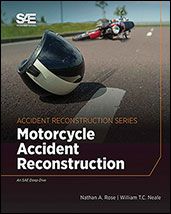Journal Article
Analysis of Vehicle-to-Ground Impacts During a Rollover with an Impulse-Momentum Impact Model
2008-04-14
2008-01-0178
This paper explores the accuracy of a planar, impulse-momentum impact model in representing the dynamics of three vehicle-to-ground impacts that occurred during a SAE J2114 dolly rollover test. The impacts were analyzed, first, using video analysis techniques to obtain the actual velocity conditions, accelerations, impact force components and the energy loss for each of the impacts. Next, these same impacts were analyzed using the known initial velocity conditions and the subject impact model. The equations of this impact model yielded calculated values for the velocity changes and energy loss for each impact. These calculated results were then compared to the actual dynamics data from the video analysis of the impacts to determine the accuracy of the impact model results. For all three vehicle-to-ground impacts considered in this study, the impact model results for the velocity changes and energy loss showed excellent agreement with the video analysis results for these parameters.


